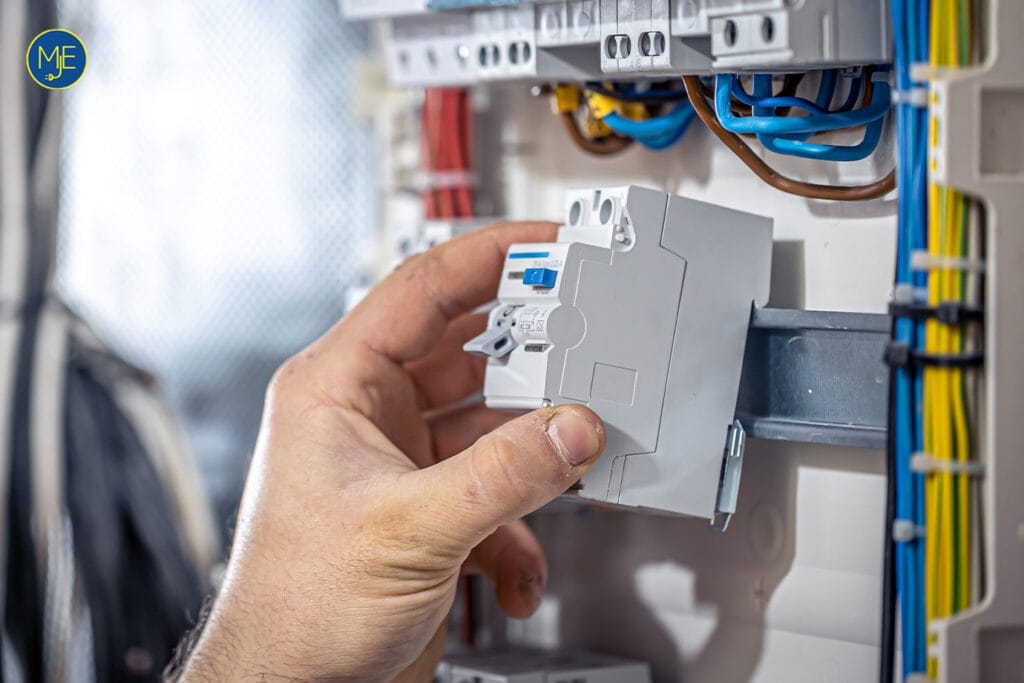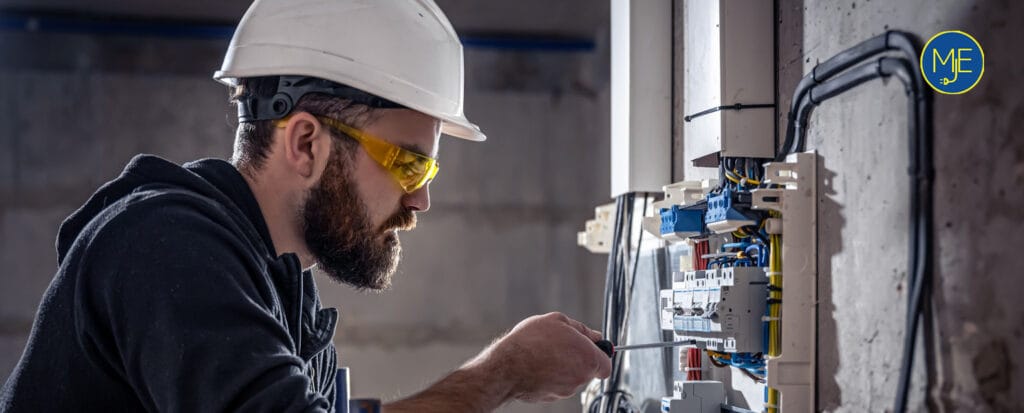As an electrician with years of experience working in homes across Ballarat, I’ve seen firsthand how important safety switches are in keeping families safe from electrical hazards.
You might not think about your electrical system much, but when something goes wrong, it’s the safety switch that steps in to prevent serious accidents.
A safety switch monitors the flow of electricity and quickly turns off the power if something goes wrong, like a current leak from a faulty appliance or wiring issue. This split-second reaction can prevent electric shocks and injuries, which could be life-threatening in some cases.
In today’s homes, we rely on more electrical appliances than ever before, and that increases the potential risks. From your kitchen appliances to your TV, faulty wiring or appliances can lead to dangerous situations. Safety switches are there to prevent those dangers by cutting off the power before any harm is done.
Making sure your home’s electrical system is safe is something I always recommend to my clients. Safety switches are a simple but essential part of that. While they quietly work in the background, their role is crucial in preventing electrical shocks, fires, or worse.
How Does a Safety Switch Work?

A safety switch monitors the flow of electricity in your home. Normally, electricity flows smoothly, but if there’s a problem, such as a faulty appliance leaking electricity, the safety switch detects it.
When this happens, the safety switch cuts off the power almost instantly, usually in milliseconds. This quick response helps prevent electric shocks and keeps you safe.
It’s important to understand the difference between safety switches and circuit breakers. Circuit breakers protect your home’s wiring and appliances from overloads, but they don’t protect people. A safety switch’s main job is to protect you and your family by stopping electricity when it detects something dangerous.
Types of Safety Switches
There are a few different types of safety switches you might come across, and each serves a slightly different purpose. Here’s a simple breakdown:
- Switchboard Safety Switches
These safety switches are installed at your home’s main switchboard. They offer protection for the entire home, covering all circuits. This means if there’s a problem anywhere in your home’s electrical system, the switchboard safety switch will turn off the power to keep you safe. It’s like having an all-in-one solution for your whole house. - Power Point Safety Switches
These are installed at specific power points around the house, usually in high-risk areas like kitchens, bathrooms, or workshops. Since water and electricity don’t mix well, having safety switches at these points adds extra protection. It’s ideal for places where you use appliances like kettles, hair dryers, or power tools that are more likely to cause electrical issues. - Portable Safety Switches
Portable safety switches are great when you’re using power away from home or where there’s no permanent safety switch installed. They’re commonly used with outdoor power tools or when working on temporary setups, like camping or doing work in the garden. These switches provide a handy, temporary layer of protection to make sure you stay safe, even when you’re on the go.
- Switchboard Safety Switches
Benefits of Safety Switches in the Home
Safety switches provide several important benefits that help keep your home and family safe. Here are the key advantages:
- Protection Against Electric Shock
The most important benefit of safety switches is that they prevent electric shocks. If something goes wrong with an appliance or a circuit, the safety switch will shut off the power before a serious injury or even a fatal accident can occur. This quick action can protect you, your family, and even visitors from harmful electrical incidents. - Minimising Fire Risks
Safety switches also help reduce the risk of electrical fires. If there’s a short circuit or a faulty appliance, it could cause sparks that lead to a fire. Safety switches act fast, cutting off the electricity before the situation gets dangerous, helping to keep your home safe from electrical fires. - Cost-Efficiency
While installing safety switches does involve an initial cost, they are a cost-efficient investment. The protection they provide far outweighs the potential expenses from property damage or medical bills if something were to go wrong. It’s a small price to pay for the peace of mind and safety they bring to your home.
Are Safety Switches Legally Required?
In many regions, safety switches are legally required to help keep homes and workplaces safe. In Victoria, for example, safety switches are mandatory in all new homes and in homes where new circuits are being installed. This means that if you’re building a new house or adding extra electrical work, like new power points, a safety switch must be part of the setup.
For rental properties, the laws are also strict. Landlords are required to ensure that safety switches are installed to protect tenants from electrical hazards. This helps create safer living conditions for renters, ensuring that electrical safety is up to standard in all kinds of homes.
While specific regulations may vary slightly from state to state, the overall goal is the same everywhere, to protect people from the dangers of electric shocks and fires. Even if safety switches aren’t required in older homes, it’s strongly recommended to have them installed to make sure your home is as safe as possible.
It’s important to know if your home is equipped with safety switches and to check that they’re working properly.
Here’s how you can find and test them:
- Identify Safety Switches on Your Switchboard
To check if you have safety switches, head to your home’s switchboard, which is usually located in a cabinet or box on a wall inside or outside your home. Safety switches are often labelled as “RCD” or “Safety Switch” and will have a small test or reset button on them. If you see these on your switchboard, you likely have safety switches installed. If you’re unsure, look for labelling or ask an electrician for help in identifying them. - Testing the Switch
It’s a good idea to test your safety switches regularly to make sure they’re working. Here’s a simple way to do it:- Find the test button on the safety switch.
- Press the button. This should trip the switch and turn off the power to that circuit.
- Go and check that the power has indeed turned off (for example, lights or appliances connected to that circuit should not be working).
- Reset the switch by flipping it back to the “on” position. The power should come back on as usual.
It’s recommended that you test your safety switches every three months to ensure they’re functioning properly. This quick check can give you peace of mind that your home is protected.
Safety Switch Maintenance and Replacement
Keeping your safety switches in good working order is essential for protecting your home and family from electrical hazards. Here’s what you need to know about maintaining and replacing them:
- Regular Testing and Servicing
Just like other parts of your home, safety switches need regular attention. Testing your safety switches every three months is a simple but important step. This ensures they’re working properly and ready to respond if there’s an electrical fault. Regular testing helps catch any issues early, so you’re not caught off guard when you need the safety switch most.
In addition to regular tests, it’s a good idea to have your electrical system professionally checked every few years. An electrician can assess the overall condition of your safety switches and make sure everything is functioning as it should. - When to Replace Safety Switches
Over time, safety switches can wear out or become less reliable. There are a few signs that might indicate it’s time to replace your safety switch:- Frequent tripping: If the safety switch is constantly tripping without a clear reason, it may be a sign that the switch is becoming faulty.
- Difficulty resetting: If you have trouble resetting the switch after it trips, or if it won’t reset at all, this could mean the switch needs replacement.
- Age of the switch: If your home or switchboard is quite old and the safety switch hasn’t been replaced in many years, it may be worth considering an upgrade to a newer model for better reliability and protection.
If you notice any of these signs, it’s best to call an electrician to assess the situation and replace the safety switch if necessary.
Prioritising Electrical Safety in Your Home
Safety switches play a crucial role in creating a safer home environment, protecting you and your family from the dangers of electric shocks and fires. By quickly cutting off power when something goes wrong, safety switches act as your first line of defence against electrical accidents.
If you’re ever unsure about the safety of your home’s electrical system, it’s always best to consult a professional electrician.
At MJE, we are licensed professionals in Ballarat, who can check your switchboard, identify any potential issues, and ensure your safety switches are installed and working properly.
The peace of mind that safety switches offer is invaluable, and maintaining them is simple. With regular testing and minimal effort, you can rest easy knowing your home is protected from electrical hazards.
Feel free to contact us for a quote.





